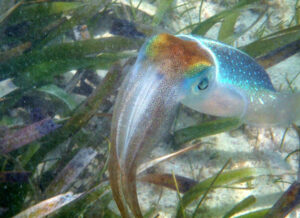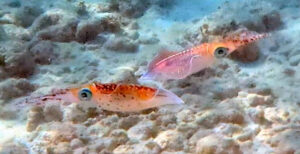Caribbean Reef Squid, Sepioteuthis sepioidea



 Caribbean Reef Squid, Sepioteuthis sepioidea. Underwater photographs taken in coastal waters of Yal-Ku, Quintana Roo, April 2016. Photographs courtesy of Juan Rojo, Akumal.
Caribbean Reef Squid, Sepioteuthis sepioidea. Underwater photographs taken in coastal waters of Yal-Ku, Quintana Roo, April 2016. Photographs courtesy of Juan Rojo, Akumal.
Phylogeny: The Caribbean Reef Squid, Sepioteuthis sepioidea (Blainville, 1823), is a member of the Lolignidae Family of Pencil Squids and is commonly referred to as the Reef Squid. In Mexico, it is known as Calamar de arrecife. There are twenty-seven global members of the Sepioteuthis Genus.
Morphology: Caribbean Reef Squid are less elongate, and more dorso-ventrally flattened than most squid, causing them to resemble cuttlefish. Their triangular fins run almost the entire length of their body, with legs are shorter than their body. Their coloration is highly variable. Generally, in the daylight, their dorsal side is mottled brown, with a longitudinal white stripe. Their ventral side is a clear light brown to whitish. This counter shaded pattern helps to camouflage them against the ocean’s bottom and surface. When confronted by a predator they have the ability to turn pale, add a eye spot to confuse the predator, and jet away. Male squid have the ability to display a zebra stripe pattern to drive away competing males. Caribbean Reef Squid have a mantle of up to 12 cm (4.7 inches) in length.
Habitat and Distribution: Adult Caribbean Reef Squid are usually associated with coral reefs during the day. Juveniles are often associated with nearshore patches of turtle grass. They are found from the ocean’s surface to depths up to 100 m (330 feet). At night, adults and juveniles both move into deeper, open water to hunt. They primarily consume fish and shrimp. The Caribbean Reef Squid is a resident of Mexican waters of the Atlantic Ocean but has a limited distribution being found in coastal waters adjacent to the Yucatán Peninsula in both the Gulf of Mexico and the Caribbean.
Diet: The Caribbean Reef Squid’s diet consists mainly of fish like the schooling sardines and arthropods like shrimp.
Reproduction: The courting ritual of the Caribbean Reef Squid involves color and pattern changing communication, the female participates in sexual selection. If selected, the male attaches a packet of sperm to the females body while displaying a pulsating pattern. The female moves the sperm packet to her seminal receptacle and then lays her eggs. Like other cephalopods, the Caribbean Reef Squid is semelparous. Female squids die immediately after laying eggs, but the male can fertilize multiple females before dying.
Human Impact: The Caribbean Reef Squid are fished commercially and sold as dried squid primarily in Southeast Asia.
Endangerment Status: The Caribbean Reef Squid is currently considered to be of Least Concern with stable widely distributed populations. However, IUCN has not evaluated the status of this species since 2015 and its population trends are currently unknown.
Synonyms: Loligo sepacea, Loligo sepoidea, Sepia affinis, Sepia officinalis jurujubai, Sepioteuthis biangulata, Sepioteuthis ehrhardti, Sepioteuthis occidentalis, Sepioteuthis ovata and Sepiacea sloanii.